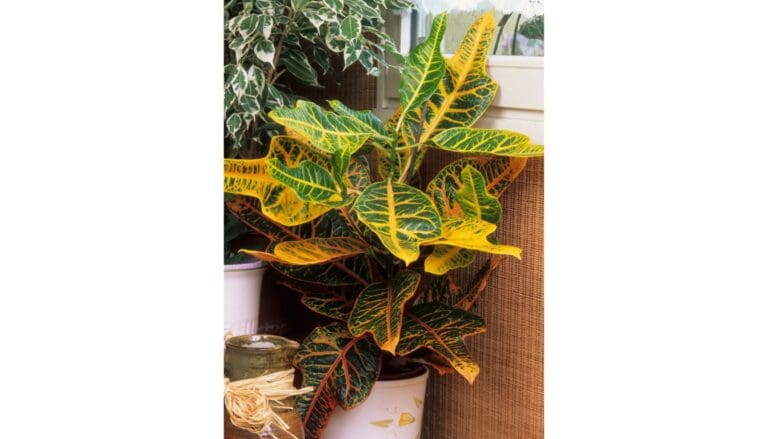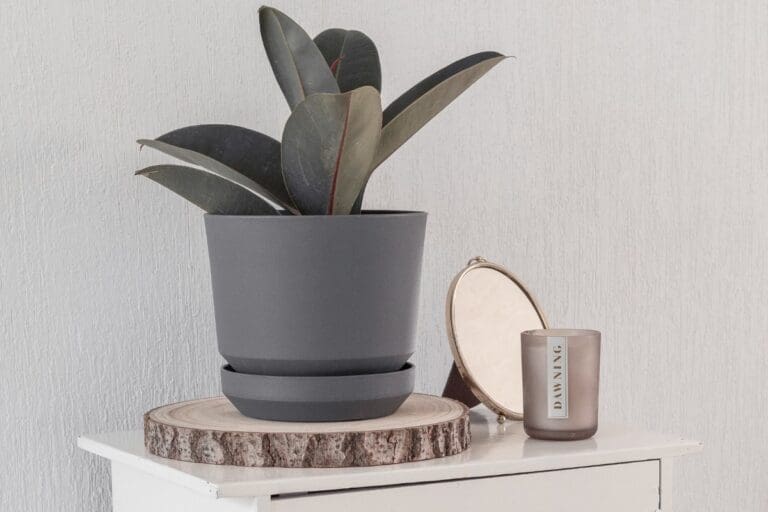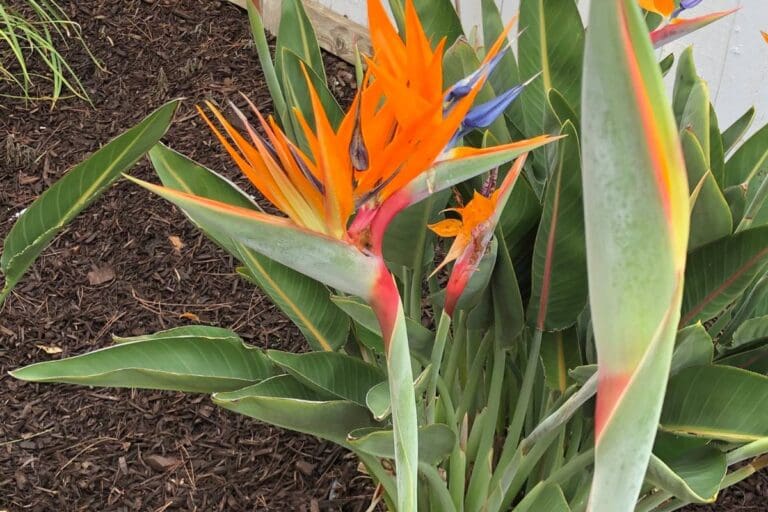Do Rubber Plants Like Coffee Grounds? (Benefits, Hazards & More)
Rubber plants are famous houseplants grown for their lush green leaves. While many fertilizer options are available for them, a common question asked by plant owners is whether they can use coffee grounds.
Coffee grounds are great for Rubber plants as they can enhance nutrient content and act as a natural pest repellent. You can utilize them as a fertilizer, compost, or mulch. However, be cautious about the potential hazards, like stunted growth, lack of other nutrients, and mold.
This article will explore the benefits of using coffee grounds in the Rubber plants, how to use them, and the associated risks. Along with that, we will also share a few alternatives to coffee grounds.

Please note: Simplify Plants is reader-supported. As an Amazon Associate, I earn from qualifying purchases made by our readers with no extra cost added to you all! Some links in the post are affiliate links and I get a commission from purchases made through links in the post.
Rubber plants and coffee grounds: Nutritional needs of Rubber plants
Coffee grounds are mainly used to make the soil nutritious.
Let’s start by exploring the nutritional needs of Rubber plants.
Rubber plants need three major nutrients – nitrogen, phosphorus, and potassium.
Some essential micronutrients are iron, calcium, magnesium, manganese, zinc, copper, and molybdenum.
With these nutrients, your Rubber plant will remain strong and thrive for prolonged periods.
Rubber plants like coffee grounds and will receive several benefits from them.
Coffee grounds, however, should not be the sole source of nutrition.
It won’t be able to provide all the nutrients to the soil.
Therefore, you must use a balanced fertilizer that meets the specific nutritional needs of the Rubber plants.
Benefits of coffee grounds in Rubber plants

I get a lot of questions from my readers through emails about whether Rubber plants will like coffee grounds or what benefits coffee can provide them.
After research and personal experience, here are some benefits of coffee grounds I found:
Soil drainage and retention
Rubber plants prefer well-drained and well-retained soil.
It can drain the excess water to prevent overwatering and root rot while holding the required moisture and preventing dehydration.
Coffee grounds can help in improving the drainage of the Rubber plant soil.
Coffee grounds are a great source of organic matter.
And we all know that organic matter does help with drainage.
It also helps in improving the retention qualities of the soil.
Nutrient content and pH level
Adding coffee grounds to the soil of Rubber plants can increase the nutrient content, especially nitrogen.
Coffee grounds can add a lot of nitrogen to the soil, increase leaf growth, and improve the plant’s overall health and development.
Since coffee grounds are acidic, it can also reduce the pH level if it has gone high.
Natural pest control
Coffee grounds contain caffeine and other compounds that can help repel pests like ants, slugs, scales, and snails.
It can benefit the houseplants and keep them bug-free.
It’s also effective for outdoor Rubber plants, especially in areas with high pest activity.
Pet repellent
If you have pets in your house, controlling them from roaming about your houseplants or chewing the leaves can be problematic.
Rubber plant leaves are toxic for pets because of the white latex.
Adding coffee grounds around the Rubber plant can keep your pets at bay.
They hate coffee, and the smell will keep them from chewing the leaves.
How to use coffee grounds in Rubber plants?
Now that you know how coffee grounds can fulfill the nutritional needs of Rubber plants and can be beneficial in several other ways, it is time to incorporate coffee grounds into the soil.
But how do you add it? Here are a few ways:
Coffee grounds as a fertilizer for tea
Here, you can mix the coffee grounds with water, make a fertilizer, and use it as a liquid fertilizer.
Fresh coffee can make the soil acidic, but diluting it with water can provide good results without any negative consequences.
However, you don’t have to use fresh coffee here. Used coffee will do the work.
There are two ways to make it:
- Boiling the grounds with hot water
- Adding it with normal water without boiling, and letting it sit.
Make a pot of coffee using the used coffee ground.
Boil some water and add used coffee grounds to it. Simmer for some minutes and turn off the gas.
Let it cool, and use liquid fertilizer tea for your Rubber plants.
Another method is to soak 2 cups of used coffee grounds in a 5-gallon bucket of normal water for a few hours.
Strain and use the water as a liquid fertilizer.
You can use this fertilizer tea as a regular liquid fertilizer or as a foliar spray. I suggest using it as a standard liquid fertilizer.
If you want foliar feeding, check it first on one leaf.
Continue if you find positive results; otherwise, stop.
Soil nutrition and composting with coffee grounds

Composting with coffee grounds will act as a slow-release, nitrogen-rich fertilizer.
I prefer this method whenever I use coffee grounds.
However, you must ensure not to use too many coffee grounds, which may cause leggy growth.
Here’s what you need to do:
- Collect used coffee grounds and let them dry on a flat surface. Avoid using sweetened or flavored coffee grounds.
- Once they have dried, mix them with soil with a ratio of 1:1. Mix the grounds well for even distribution.
- To balance the soil’s pH level, add some organic compost. The coffee grounds, soil, and compost ratio should be 1:1:1.
- Once the soil mix is done, plant your Rubber plants. Provide enough water.
- Check your Rubber plant daily and see how it reacts to adding coffee grounds.
- Use coffee grounds in moderation and always mix them with organic matter to avoid adverse effects.
Another way to compost with coffee grounds is to add them to a compost pile. Later you will use this compost to the soil.
It is better to treat the coffee grounds as green compost.
They are 2% nitrogen by volume and should be balanced with the other brown compost, like leaves and shredded paper.
Add ⅓rd leaves, ⅓rd grass clippings, and ⅓rd used coffee grounds to the compost pile.
Mix them well and turn and aerate them regularly to keep them aerobic.
Add this compost with the soil mix.
Avoid excessive use of coffee grounds.
They are high in nitrogen and can alter the pH level.
That will hurt the Rubber plants instead of doing any good.
Coffee grounds as mulch and moisture management
Another excellent way to use coffee grounds is as mulch.
Using coffee grounds as mulch is ideal if you live in extremely hot or cold weather.
In hotter climates, soil can dry out faster.
In the winter, the Rubber plants need less watering, and cold can reach the roots and harm them.
During the hot climates, mulch will trap moisture and won’t allow the soil to dry out faster.
You don’t have to water the plant too often.
During winter too, the mulch can trap moisture.
Therefore, you don’t have to overwater them.
Additionally, it will keep the soil warm and won’t let cold weather reach and damage the roots.
Scatter the used coffee grounds around the soil to mulch your Rubber plants.
Ensure the coffee grounds are not dry.
Otherwise, they won’t accept the moisture you provide.
As time passes, the mulch will decompose and add necessary nutrients to the soil.
Coffee grounds as a pest-repellent
In this method, the grounds will help in repelling pests.
Add 2 tablespoons of used coffee grounds, one cup of herbs like lavender, dill, or oregano, and two cups of water.
Let it steep for one a day.
Strain the water, transfer it to a spray bottle, and spray the plant.
Coffee grounds hazards and challenges

By now, you have learned the benefits of coffee grounds and how to use them in the Rubber plants for their betterment.
Besides, you must also learn the negative impacts of using coffee grounds to stay cautious before using them.
Here are some hazards and challenges you might face while using coffee grounds for Rubber plants:
Offers only nitrogen
Coffee grounds are very rich in nitrogen.
They will have 10% of nitrogen after brewing.
Therefore, you should not use coffee grounds as the sole source of fertilization.
Excessive nitrogen increases too much leaf growth and makes your plant leggy.
Coffee grounds also have carbon and a few more compounds.
Unfortunately, the amount is relatively lower than needed, and the plant absorbs them very slowly.
Do not rely only on coffee grounds.
Alters the pH level
Coffee grounds are acidic, and fresh or unused are immensely acidic than used coffee grounds.
Though it might be helpful when your ground has high alkalinity, it should be used in a few amounts.
Excessive coffee grounds can reduce the soil’s pH level and make it too acidic. As a result, it will harm the health of the Rubber plants.
Coffee is an antibacterial ingredient.
All plants, including Rubber plants, have some beneficial bacteria that keep the plant healthy.
The microorganisms that produce nitrogen from feeding the coffee grounds can die when they consume too much coffee.
As a result, your plant can become weak and easily susceptible to pests and diseases.
Stunted growth
Excessive use of coffee grounds can reduce weed growth.
While it is something to be happy about, it can also lead to the stunted growth of the Rubber plants.
Coffee grounds can damage the roots of new and young plants and don’t allow them to be well-established.
After the roots take hold, the caffeine in used coffee grounds can restrict plant growth, causing stunted growth.
Fungal infections
Some plant fungi will love coffee grounds.
You will even find mushrooms at the plant base if you frequently use too much coffee grounds.
While mushrooms can be ideal if you want some, they won’t be ideal for the health of your Rubber plants.
Over time, you will notice mold growth.
How much and how often to use coffee grounds in the Rubber plants?

Coffee grounds benefit Rubber plants but be aware of their potential drawbacks.
Let me briefly share how much and how often to use coffee grounds to avoid risks:
- Add ¼th cup of used coffee grounds for safety with every 4 to 6 cups of potting mix.
- Add 30% each of leaves, grass clippings, and used coffee grounds for the compost pile.
- For liquid fertilizer, use 2 cups of coffee with 5-gallon water.
Now, how frequently should you use coffee grounds?
Generally, it is recommended to use it once a month or every 2 months.
Try to use it sparingly, only when needed.
Monitor the soil pH and adjust as needed.
If necessary, stop using coffee and switch to a balanced houseplant fertilizer that doesn’t alter the soil pH.
Things to consider while using coffee grounds in Rubber plants
Since coffee grounds have some drawbacks, using them carefully can help prevent them and keep your plant from suffering.
Here are some things to keep in mind while using coffee grounds in the Rubber plants:
- Use coffee grounds moderately. They can increase nitrogen levels and soil acidity. Mix it with organic compost or water to dilute and reduce its concentration.
- While using the coffee grounds, keep monitoring the pH levels of the soil with a soil pH meter and adjust as needed.
- Avoid using fresh coffee grounds. They are highly acidic and can harm the plants. Instead, use brewed, dried, or composted coffee.
- Coffee grounds can affect drainage. Therefore, water the Rubber plants carefully. Let the top few inches dry before you water them next.
Alternatives to coffee grounds for Rubber plants
Instead of using coffee grounds, several other fertilizers can fulfill the nutritional needs of the Rubber plants.
A high-quality houseplant fertilizer will keep the Rubber plants healthy and encourage deep green leaves.
You can use a balanced liquid fertilizer with an NPK ratio of 10-10-10 for better results.
Try this Bonide 10-10-10 Indoors Fertilizer for the plants.
A formulated fertilizer provides better benefits to your plant than coffee grounds without any risks.
You can add organic matter to the soil for enough nutrients.
Unlike coffee grounds that only provide nitrogen, organic matter will provide maximum nutrients.
While coffee grounds can quickly provide a dose of nitrogen to the Rubber plants, you cannot overlook the hazards of using them in the long term.
Coffee grounds are good, but providing them frequently is not ideal. 1-2 applications are more than enough.
Approach for other ways to provide nitrogen and address the imbalanced pH levels of the soil.
Final thoughts
While coffee grounds benefit Rubber plants, excessive use can harm their health and development. You can use coffee grounds as a liquid fertilizer, composting, mulch, or pest-repellent. But make sure to use it in the right amounts and less frequently. Using too much coffee can result in acidic soil, a lack of beneficial bacteria, stunted growth, and fungal infections.
Invest in a good, balanced liquid fertilizer and use it every 2-4 weeks throughout the spring and summer to fulfill the nutritional needs of the Rubber plant instead of solely relying on coffee grounds. If you must use coffee grounds, keep certain things in mind, for example, the amount and frequency of using coffee. Observe the soil’s pH level and check for mold growth so that you can take immediate action.
Maintain a consistently moist soil and water the plant whenever the top few inches have dried. Along with these, provide good indirect sunlight, maintain warm temperature and average humidity, prune regularly and repot once during the active months, and protect from cold drafts. With these few tips, you can safely use coffee grounds for the Rubber plants and encourage good growth.
What is the best fertilizer for Rubber plants?
Use a balanced liquid fertilizer, such as 10-10-10 or 20-20-20, applying it every 2-4 weeks in spring and summer. If you use slow-release food, apply it every 4-6 weeks during the growing months.
Do Rubber plants love acidic soil?
Rubber plants enjoy growing in soil with a pH of 5.5 to 7. It means that they enjoy slightly acidic to neutral soil. While using coffee grounds, do keep an eye on the pH level.
Reference: Rubber plant Wikipedia
Recommended Garden Supplies
| Product Image | Our Recommended Gardening Supplies | Check Offers! |
|---|---|---|
Top Top
Top
Top
Top
Top
Top
Top
Top | rePotme Houseplant and Tropical Classic Potting Soil Mix | Check Offer On Amazon |
 Top
Top
Top
Top
Top
Top
Top
Top | Espoma Organic Indoor Plant Food | Check Offer On Amazon |
 Top
Top
Top
Top
Top
Top
Top
Top | GooingTop LED Grow Light 6000K Full Spectrum Clip Plant Growing Lamp | Check Offer On Amazon |
 Top
Top
Top
Top
Top
Top
Top
Top | Soil Moisture Meter | Check Offer On Amazon |
 Top
Top
Top
Top
Top
Top
Top
Top | Govee Hygrometer Thermometer, Bluetooth Enabled! | Check Offer On Amazon |
 Top
Top | LEVOIT Humidifiers for Large Room(Best For Plants) | Check Offer On Amazon |
 Top
Top
Top
Top
Top
Top
Top
Top | Upgraded DIY Automatic Drip Irrigation Kit, 15 Potted Houseplants Support | Check Offer On Amazon |
 Top
Top
Top
Top
Top
Top
Top
Top | Stainless Steel Heavy Duty Gardening Tool Set | Check Offer On Amazon |
 Top
Top
Top
Top
Top
Top
Top
Top | Bonide Insecticidal Soap | Check Offer On Amazon |
 Top
Top
Top
Top
Top
Top
Top
Top | Bonide 32 oz Spray Neem Oil for Organic Gardening | Check Offer On Amazon |
 Top
Top
Top
Top
Top
Top
Top
Top | Garden Safe Fungicide | Check Offer On Amazon |






